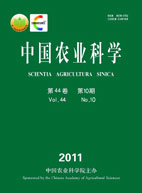-
Effect Function of NPK Fertilization, N Fertilization in Different Stages and Its Application in Formula Fertilization on Cauliflower
- LI Guang-Qing, XIE Zhu-Jie, YAO Xue-Qin
-
Scientia Agricultura Sinica. 2011, 44(10):
2070-2080.
doi:10.3864/j.issn.0578-1752.2011.10.012
-
 Abstract
(
717 )
Abstract
(
717 )
 PDF (380KB)
(
896
)
PDF (380KB)
(
896
)
 Save
Save
-
References |
Related Articles |
Metrics
【Objective】 The purpose of the study is to establish effect function models of N, P, K fertilizer balanced application and the N fertilizer application in different stages for winter cauliflower and to apply that in soil test for fertilization according to calculation formula of recommended fertilization rate toward different production targets.【Method】Using a mid-maturity winter cauliflower variety ‘120 Tian’, the “311-A” optimization regression design was used to conduct field experiments of N, P, K fertilizers and to build the models of the effect of balanced N, P, K fertilization , N fertilizer application and content of glucoraphanin. Simplex lattice design was used to conduct field experiments of N fertilizer in different stages and to build the model of the effect of N fertilization. The combination of fertilization effect model and soil test analysis could further recommend the optimal fertilization for cauliflower production.【Result】There were extremely significant correlation between yield, appearance eligibility ratio and the coded value of N, P, K. The N, P, K optimal combination on yield was N 327.83 kg•hm-2, P2O5 89.65 kg•hm-2, K2O 201.41 kg•hm-2, and the maximum yield was 19 089.25 kg•hm-2. Further analysis showed that a good distribution ratio of N fertilizer application rates before field planting, at the early growth stage and at later growth stage was 0.4313:0.2427:0.3260. The N, P, K optimal combination on appearance eligibility ratio was N 434.20 kg•hm-2, P2O5 90.11 kg•hm-2, K2O 213.92 kg•hm-2, and the maximum appearance eligibility ratio was 84.95%. There were significant effects on the content of glucoraphanin by applying N fertilizer. When N fertilizer application reached 394.62 kg•hm-2, glucoraphanin content would get to maximum. The optimal fertilization for cauliflower production of 30 field parcels could further recommend by the combination of fertilization model and soil test analysis, according to calculation function of recommended fertilization rate toward different production targets. The results showed that the different optimal combinations of applying N, P, K fertilizers could be carried on, according to the different targets and soil nutrient level. For example, toward the maximum yield of 30 different plots, the maximum of recommended N, P and K fertilization rate were 7.92%, 10.21%, and 68.39% more than the minimum, respectively. 【Conclusion】 Toward the different plots and production targets, the N, P, K fertilization rate could be recommended according to the optimal fertilization effect function model and recommendation calculation function.









